In this Issue
- Codling moth: updated spray dates table for apple and pear
- San Jose scale: treat now (if present last year) for apple and pear
- Peach twig borer: treat now (if not already) for peach, apricot
- Greater peachtree borer: treat lower trunks of peach and nectarine in about 10 days
- Western cherry fruit fly: treatment should start when fruits turn salmon blush color
APPLE, PEAR
Codling Moth
Be mindful that no treatment is needed between the end of first generation egg hatch and start of second generation
View a pdf of the spray timing table.
For most northern Utah locations, the June heat has pushed the end of the first generation egg hatch to be around the end of this month. Our predictions are not “perfect” but in general, you do not need to apply a spray between the end of the first generation egg hatch and the start of the second, because there are no larvae present.
Treatment
San Jose Scale
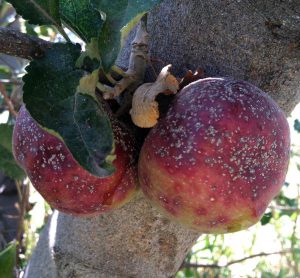
For all northern Utah locations, treat now (between June 15 and 18)
Scales are immobile insects with a hard “shell.” They feed on tree sap through a straw-like mouthpart. They are often difficult to see with the naked eye; a 10-20x hand lens helps.
San Jose scale (SJS) primarily occurs on apple, and sometimes pear. It looks like a small pimple or large pepper flake. It can be found on fruit, twigs, scaffold branches, and the main trunk.
If your trees have SJS and you applied a dormant oil spray, most overwintering adults will have survived that spray. Therefore, a treatment targeting newly hatched nymphs (called crawlers) will need to be applied now. Each adult female lays about 200 eggs. The crawlers walk or are windblown to new sites to settle on twigs or fruit, insert their mouthparts, and feed for the remainder of their lives. Once they form their hard outer covering, they are more resistant to pesticides.
If the scale population is left untreated, the fruit becomes small and deformed. The tree loses vigor and branches may start to die. It is primarily a problem in standard-sized, poorly pruned trees.
Treatment
- Residential Organic: insecticidal soap (apply three times 5 days apart); horticultural oil (apply 3 times 5-7 days apart)
- Residential Conventional: Spectracide Triazicide or GardenTech Sevin (apply once)
- Commercial: click here; Esteem or Centaur work best
PEACH/NECTARINE, APRICOT
Peach Twig Borer
Treat first generation now (if not already) in all northern Utah locations
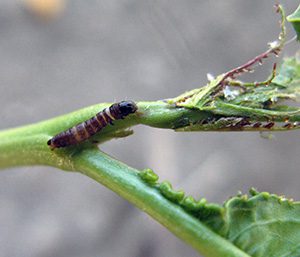
Peach twig borer larvae feed on twigs and fruits of peaches, nectarines, and apricots. Unlike codling moth on apples, this pest is more sporadic in Utah, and some locations have a low enough population that does not need to be treated.
Generally, just a single application is sufficient for the first generation. This spray will lower the population, and prevent shoots from being attacked.
But during the second generation (which can attack the fruit), you may need to apply insecticide regularly so that your tree is protected throughout the egg-hatch period. Those dates will be provided in July.
Treatment
- Residential: Treatment options are the same as for codling moth.
- Commercial: For options, click here.
Greater Peachtree Borer
Spray lower trunks in Wasatch Front, Iron County, northern Washington County locations in about 10 days
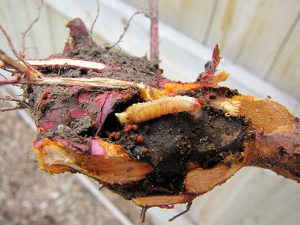
The greater peachtree borer is a moth, and adults lay eggs on the lower trunk. Spraying that area (10″ up from the ground plus exposed roots) with an insecticide will kill any eggs that are laid by the female moths. Otherwise, a larva will hatch and immediately bore into the tree trunk and feed on the inner bark and cambium.
The larvae stay within the lower trunk until the following spring. This is when people notice gumming mixed with frass at the base of the trunk, or even just below the soil line.
When to Treat
- Cache County: July 4
- Iron County: June 24
- Uintah County: June 26
- Wasatch Front (range from warmer to cooler locations): June 18 – June 27
Treatment
- Residential: permethrin, such as Hi Yield brand. Apply at the appropriate timing, and repeat once per month, with the last application in September.
- Organic options include products that contain either pyrethrin or azadirachtin (AzaSol, EcoGarden). They need to be applied weekly.
- Commercial: click here
CHERRY
Western Cherry Fruit Fly
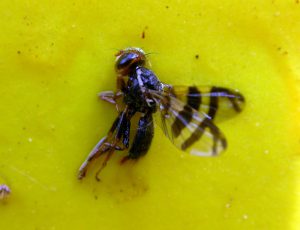
Begin protecting fruits when they turn a salmon blush color
The time to treat for the “worms in the cherry” is based on the development of your own tree. Watch the fruit color. It will go from green to yellow, and then quickly develop a rosy blush. Once that rosy blush forms, the female flies are able to penetrate the fruit skin and lay eggs inside.
Therefore, treatment should begin as soon as cherries develop a salmon blush color. Base this off the fruits in the sunniest location of the tree, which is often toward the top or on the outside edges.
Treatment
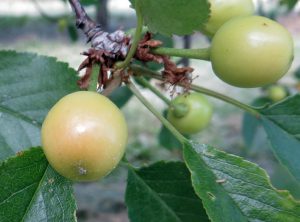
Residential Conventional:
- Malathion (malathion): every 7 days
- Bonide Fruit Tree Spray (carbaryl): every 14 days
- Bonide Fruit Tree Spray & Plant Guard (lambda-cyhalothrin), GardenTech Sevin (zeta-cypermethrin), Spectracide Triazicide (gamma-cyhalothrin): every 14 days
Residential Organic:
- Fertilome / Gardens Alive / Bull’s Eye / Monterey (spinosad): every 7 days
- AzaSol, EcoGarden (azadirachtin; purchase online): every 7 to 10 days
Commercial Growers:
- Commercial growers, click here.
